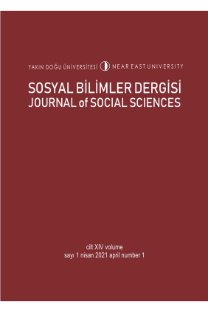Hedonik tüketim ile cinsiyet ve gelir değişkenleri arasındaki ilişkinin analizi
Modern anlamda pazarlamanın odak noktası tüketicidir. Bu nedenle, üretim öncesi süreçten başlayarak tüm işletme faaliyetlerinde tüketici davranışlarının sürekli incelenmesi gerekmektedir. Tüketici, değişken bir varlıktır. Tüketici, sadece ihtiyaçları için satın alma davranışı göstermez. İhtiyaçlarının dışında kişisel zevk ve haz duymak için de satın almada bulunur. Bu çalışmada, tüketicilerin alışveriş yapmaktan duydukları hazzı içeren hedonik tüketim kavramı literatürdeki farklı bakış açılarıyla incelenmiştir. Üniversitede okuyan öğrencilerin hedonik tüke- time bakışları ile cinsiyet ve gelir arasındaki ilişkiyi belirlemek üzere anket formu oluşturulmuştur. Elde edilen veriler SPSS 17 programında analiz edilmiştir. Çalışma sonucunda, hedonik tüketim ile cinsiyet arasında ilişki bulunmuş ancak gelir değişkeni ile ilişki bulunamamıştır.
An analysis of the relationship between hedonic consumption and gender, and revenue
The focus of modern marketing is consumers. Therefore, beginning of the pre - production process, in all of business activity consumers’ behavior continuously need to be investigated. Consumers are variably entity. Consumers do not indicate only buying behavior for needs. Except of the needs consumers buy for personal fancy and pleasure. In this study, a hedonic consumption concept which includes consumers shopping pleasure is surveyed with different aspect in literature. The relationship between university students aspect to hedonic consumption with gender and income are composed questionnaire form. Data are ana- lyzed with SPSS 17. As a result of study there is a relationship between hedonic consumption and gender but there is no relationship between hedonic consumption and income.
___
- AYDIN S., (2010) “Hedonik Alışverişin Cinsiyet, Gelir ve Yerleşim Büyüklüğü- ne Göre Farklılaşması Üzerine Bir Araştırma”, Süleyman Demirel Üniversitesi, İktisadi ve İdari Bilimler Fakültesi Dergisi, 15 (3), s. 435-452.
- BABIN B. J., DARDEN W. R., GRIFFIN M., (1994) “Work and/or Fun: Measuring Hedonic and Utilitarian Shopping Value”, Journal Of Consumer Research, 20 (3), p. 644-656.
- BAUDRILLARD, J. (2004) Tüketim Toplumu, çev. H. Deliceçaylı, Sarmal Yayın- ları İstanbul.
- CHANG, E., The Mediating Role of Hedonic Shopping Value in Apperal Shopping Satisfaction, Submitted to Oregon State University in Partial Fullfillment of the Requirements for The Degree of Doctor of Philosophy.
- CHILDERSA, T., L. CHRISTOPHER, L. C., JOANN P., STEPHEN C. (2001) “Hedonic and Utilitarian Motivations for Online Retail Shopping Behavior”, Journal of Retailing, 77, pp. 511-53.
- FROMM, E. (1991) Sahip Olmak ya da Olmak, çev. Aydın Arıtan, Arıtan Yayı- nevi, İstanbul.
- HIRSCHMAN, E. C., MORRIS B. H. (1982), “Hedonic Consumption: Emerging Concepts, Methods and Propositions, Journal of Marketing”, 46 (Summer), pp. 92-101.
- HUNT A. (1996) “Compulsive Buying Studied by Marketing” Jim Roberts, Baylor Business Review, Vol. 14, No: 2, pp. 10.
- HOPKINSON G. C., PUJARI D., (1999) “A Factor Analytic Study of the Sources of Meaning in Hedonic Consumption”, European Journal of Marketing, Vol. 33, No. 3/4, pp. 273-290.
- ODABAŞI Y., BARIŞ G., (2002) Tüketici Davranışı, MediaCat Kitapları, İstanbul.
- ÖZDEMİR Ş., YAMAN F., (2007) “Hedonik Alışverişin Cinsiyete Göre Farklı- laşması Üzerine Bir Araştırma”, Eskişehir Osmangazi Üniversitesi İİBF, Ekim, No: 2, Cilt: 2, s. 89.
- SCHAUGNESSY J, O’Schaugnessy N. (2002) “Marketing the Consumer Society and Hedonism”, European Journal of Marketing, Vol. 35, No: 5/6, pp. 524-547.
- SCHERHORN G., L. A. REISCH, G. R., (1990) “Addictive Buying in West Germany: An Emprical Study”, Journal of Consumer Policy, Vol. 13, pp. 355- 387.
- SLAMA, M. E., TERRELL G. W. (1990) “Generalization of the Market Maven’s Information Provision Tendency Across Product Categories”, Advances in Consumer Research, 17, pp. 48-52.
- SPANGENBERG E. R., VOSS K. E., CROWLEY A. E., (1997) “Measuring the Hedonic and Utilitarian Dimensions of Attitude: A Generally Applicable Scale”, Advances in Consumer Research, Volume 24, pp. 235-241.
- http://www.arastirmacilar.org/default.asp?tid=5022&lng=tr (04.06.2007)
- ISSN: 1986-1303
- Yayın Aralığı: Yılda 2 Sayı
- Başlangıç: 2008
- Yayıncı: Yakın Doğu Üniversitesi
Sayıdaki Diğer Makaleler
The financial outlook of Turkish social security system: Can social security deficits be alleviated?
Hedonik tüketim ile cinsiyet ve gelir değişkenleri arasındaki ilişkinin analizi
Digitalized memory, forgetting and the loss of social memory
DİLEK ÖZHAN KOÇAK, Orhan Kemal KOÇAK
Futbolun değişen yapısı üzerine sosyolojik bir analiz
